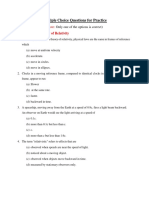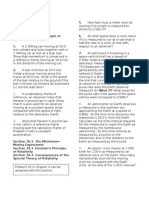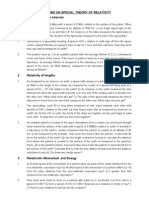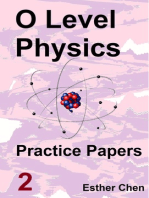Tutorial_ Relativity
Uploaded by
ExtraTutorial_ Relativity
Uploaded by
ExtraTutorial Sheet 2-Relativity
1. Using Lorentz transformation equations show that
x '2 c2 t ' x 2 c2 t 2
2. A frame of reference S’ is moving with respect to frame S with velocity 0.8 c along the
common axis X-X’ axis. An event occurs in S’ at x’ = 120 m, y ' 15m, z ' 10m and
t ' 5 103 s. Evaluate the space-time coordinates of this event in frame S.
3. A rocket ship is 100 metre long on the ground. When it is in flight, its length is 99 metre
to an observer on the ground. What is the speed?
4. An airforce rocket is chasing enemy’s spaceship. From earth, it is found that the speed of
airforce rocket is 2.55 × 1010 cm/sec while that of enemy ship is 2.25 × 1010 cm/sec. What
is the relative velocity of
(i) Enemy’s ship as seen by airforce rocket.
(ii) Airforce rocket as seen by enemy’s ship.
(iii)Airforce rocket with respect to enemy’s ship as seen from earth
(iv) Enemy’s ship with respect to airforce rocket as seen from earth.
5. Calculate the speed of the particle when its kinetic energy if (i) equal to its rest mass
energy, (ii) twice of its rest mass energy, and (iii) half of its rest mass energy .
6. Calculate the rest mass, relativistic mass and momentum of photon of energy 5 eV.
7. Calculate the expected fringe shifts in the Michelson-Morley experiment, if the distance of
each plate is 2 m and the wavelength of monochromatic radiation is (a) 6000Å and (b)
4000Å.
8. In an experiment similar to the one performed by Michelson and Morley, the distance l of
the semi-silvered plate from either of the mirrors is 25.90 m. The wavelength of light used
is 589.0 mm. (a) Calculate the time lag between the two beams reaching after reflection. (b)
After the apparatus is rotated through 90°, what is the total time lag? (c) Determine the
number of fringes shifted. Assume orbital v of the earth about the sun = 3 × 104 m/s.
9. A neutral meson of Energy E moving at a speed v decays into two γ-rays, one is of energy
E1 = 70 MeV along the direction of the neutral meson and the other is of energy E2 = 60
MeV opposite to the former. Calculate the rest mass of the meson.
You might also like
- Fig.a Fig.b: Tanh (+ (Tanh + Tanh / (1 + Tanh - Tanh)No ratings yetFig.a Fig.b: Tanh (+ (Tanh + Tanh / (1 + Tanh - Tanh)2 pages
- Revisiting The Michelson and Morley Experiment To Reveal An Earth Orbital Velocity of 30 Kilometers Per SecondNo ratings yetRevisiting The Michelson and Morley Experiment To Reveal An Earth Orbital Velocity of 30 Kilometers Per Second20 pages
- Maharashtra Board (MSBSHSE) Physics Class 12 Question Paper 2016No ratings yetMaharashtra Board (MSBSHSE) Physics Class 12 Question Paper 201632 pages
- Problems Based On Space Weather and Space RadiationsNo ratings yetProblems Based On Space Weather and Space Radiations5 pages
- PH101: Physics I: Module2: Special Theory of RelativityNo ratings yetPH101: Physics I: Module2: Special Theory of Relativity2 pages
- (25387) 22. H Special Relativity QuestionsNo ratings yet(25387) 22. H Special Relativity Questions4 pages
- Physics: Kcet Model Paper-01 (Offline) - 21No ratings yetPhysics: Kcet Model Paper-01 (Offline) - 217 pages
- 1 Denitions: Inertial Frame of Reference (IF)No ratings yet1 Denitions: Inertial Frame of Reference (IF)6 pages
- ICSE Class 11 Annual Exam Model Question Paper 2 - PHYSICSNo ratings yetICSE Class 11 Annual Exam Model Question Paper 2 - PHYSICS3 pages
- Course Instructors: Pankaj Mishra and Tapan Mishra Tutorial-6 Due On Wednesday, 16th of October, 2019 (8:00Hrs IST)No ratings yetCourse Instructors: Pankaj Mishra and Tapan Mishra Tutorial-6 Due On Wednesday, 16th of October, 2019 (8:00Hrs IST)2 pages
- Problems Based On Space Weather and Space RadiationsNo ratings yetProblems Based On Space Weather and Space Radiations3 pages
- Upsc Physics Optional Tutorial Sheets PDFNo ratings yetUpsc Physics Optional Tutorial Sheets PDF51 pages
- Reflections on the Michelson-Morley Experiment and the Ineluctable Self-InterviewFrom EverandReflections on the Michelson-Morley Experiment and the Ineluctable Self-InterviewNo ratings yet



























































